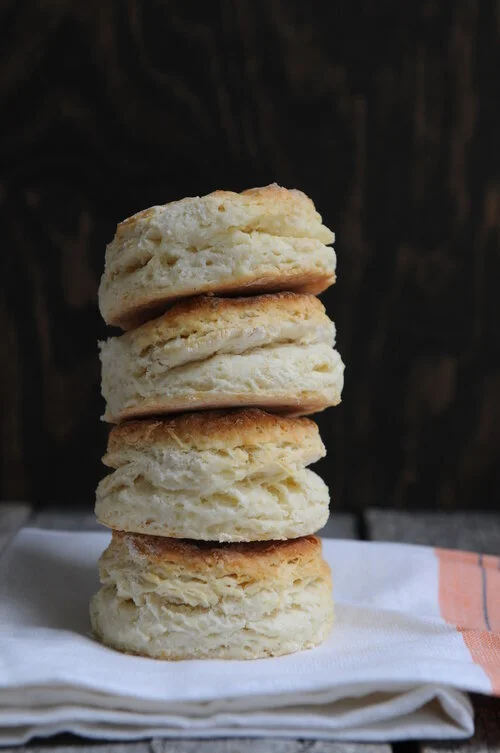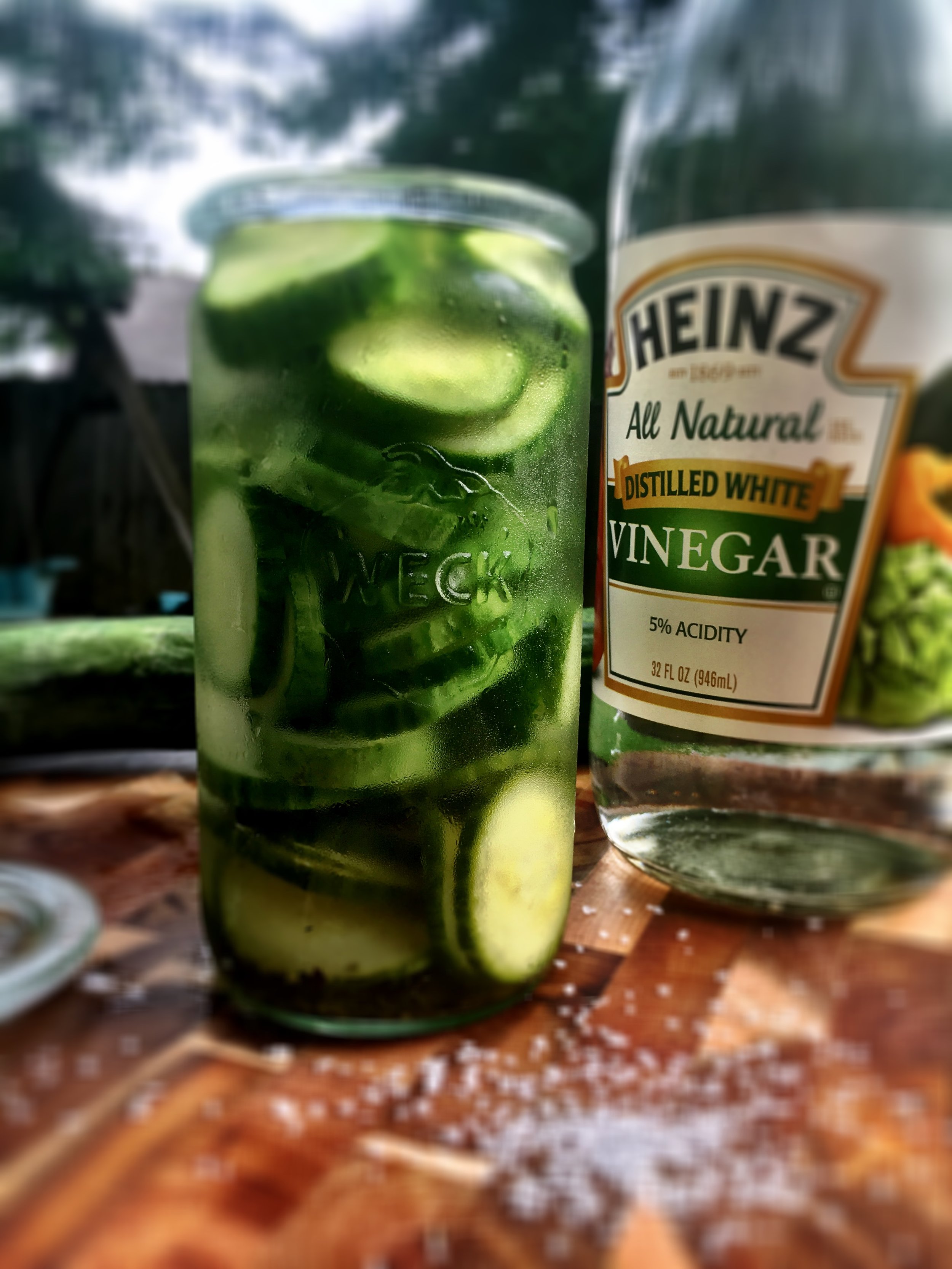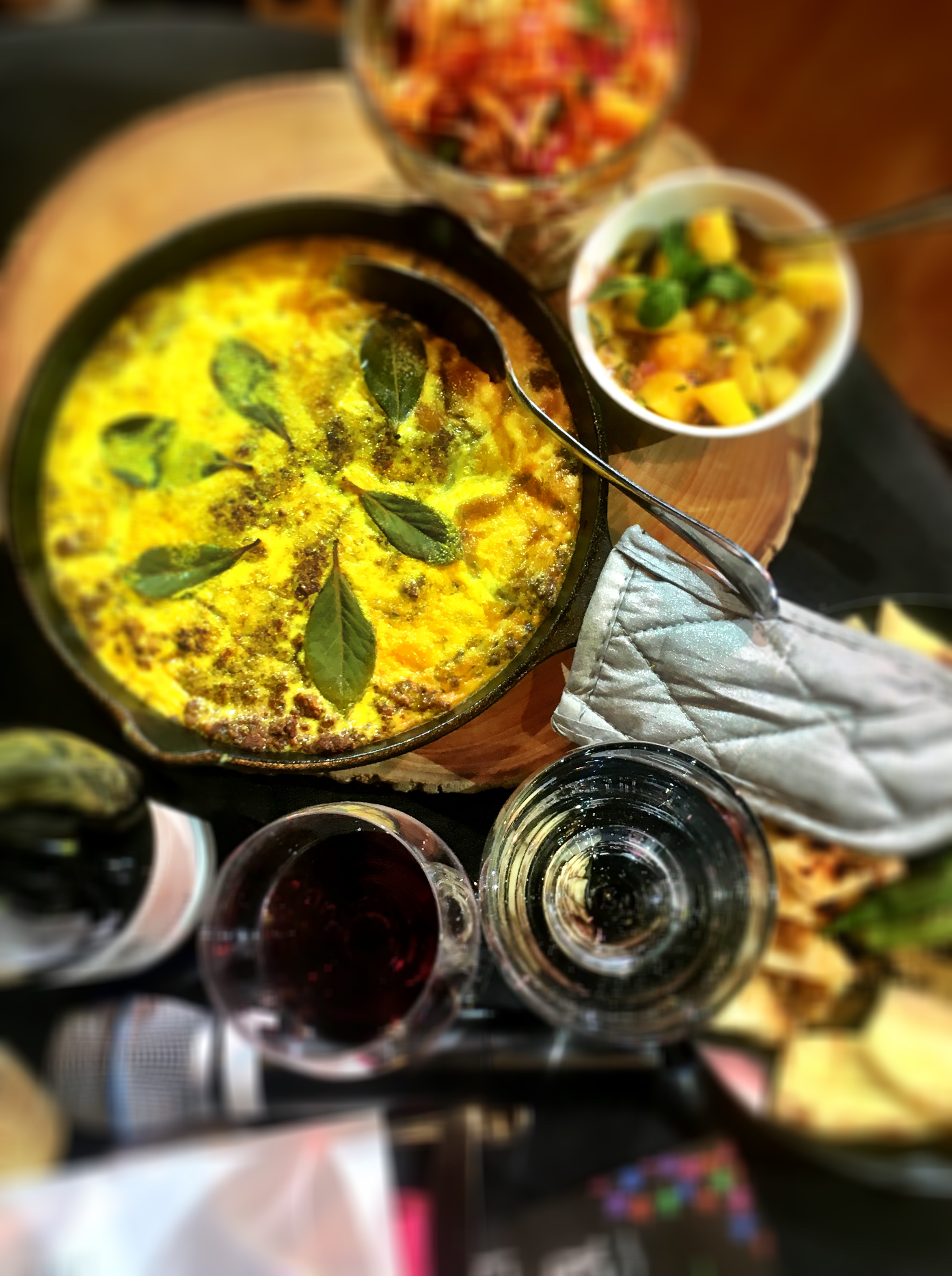I also wanted to share my Pappa Was a Rolling Scone (Biscuit) recipe, albeit a little messy, but one hell of a delicious pedestal for any fruit based dessert, or even as an amazing breakfast accoutrement with either butter, jam, or honey.
Refrigerator Cucumbers - Missouri Childhood in a Jar
Racing my bike through the streets of my small hometown was an integral part of my childhood; always en route to morning swim team practice with a towel wrapped tight around the center handle bars, the city park to roam and play, the fair grounds that connected a series of bike trails in the dense woods on the edge of town, the Wednesday matinee where I first held a girl's popcorn buttery hand, and at least one stop a day at either one of my grandparent's homes to raid their always fully stocked refrigerator. I could count on very specific foodstuffs, depending on my destination that day; my father's parents always had cold sliced cantaloupe, bologna, RC Cola, and frozen ice cream drumsticks covered in chopped nuts; while my mother's folks maintained a fridge chock full of cranberry juice, leftover bacon from breakfast, fresh peaches from the family orchard, fried okra and onions, pork rinds, the original Chips Ahoy chocolate chip cookies, and a large Tupperware container filled with ice cold cucumbers and onions in white vinegar.
The refrigerator cucumbers were my favorite - fresh, cold, puckering tart, and utterly refreshing in the middle of those sweltering, humid Missouri summer days. I stood with the heavy door opened, propped against my skinny, tan legs - holding the cold Tupperware against my belly (yes, there was a time when I wore a half shirt in the early 80s) while I clamped thumb and index finger around the floating coins to plop into my mouth, one after the other. When I had my fill, I raced back into my care-free childhood, screen door banging loudly behind.
As complicated as cooking could be for the recipes and meals devised by the women in my family, these quick pickles were surprisingly simple and easy to prepare. Usually, the cucumbers were harvested from the garden, layered with sliced red or yellow onion, then covered with vinegar that had been embellished with a whisper of salt, sugar, and pepper. And that was it...
As much as things have changed, they've also stayed the same in many ways. I still stand mesmerized in front of an open fridge eating leftovers, drinking milk, or sometimes a cold beer in the middle of the night - but my favorite refrigerator ritual still involves standing in the glow of the intermittent light, munching with eyes rolled back on the nostalgic, tart, ice cold cucumbers from my childhood, albeit sans the half shirt, but now that I think about it, probably sans a shirt at all.
Refrigerator Cucumbers
1 English Cucumber
2 Cups White Vinegar
1/4 Cup Salt
2 Turns Cracked Black Pepper
Technique - Slice the cucumber into thin coins - place in jar or Tupperware container - cover completely with vinegar, add salt and pepper - chill for at least two hours - then devour.
Just Like Honey
The crowd of 200 plus hungry guests quieted down for a beat and then, once the sign was given, began making a soft, communal “Buzzzzzing” sound that quickly turned into a loud, nearly deafening crescendo for over a dozen seconds. Was this a world record for the largest human group making bee-like sounds? Perhaps – but it was actually an exercise in community whimsy that has become just another fun, albeit inexplicable component of the monthly Wednesday Over Water event meant to give an important, informal twist to the intersection of food and art.
The museum welcomed famed “Honey Sommelier” Marina Marchese for two days of insight and sensory experience situated around the artisanship of beekeeping and evaluating honey. Of course for WOW, the culinary team devised a beautiful, sublime menu featuring creamy chevre, traditional baklava, and roasted duck (see recipe below), all sharing the diverse virtues and flavor profiles of locally harvested nectar. Ms. Marchese mesmerized the audience with her life story, which includes two books written on the subject; The Honey Connoisseur Selecting, Tasting, and Pairing Honey, co-authored with Kim Flottum (editor of Bee Culture Magazine), and Honeybee Lessons from an Accidental Beekeeper that was published in 2009.
I was mesmerized by Marina just in the correspondences we shared prior to her arrival; particularly when she asked if I could procure a special ultra-rare variety of KUDZU honey that was specific to the southern parts of the United States. “It has a gorgeous, light blue tint in its color,” she described, “and the flavor profile is analogous to a Jolly Rancher candy.” I immediately went on a search for the elusive prize, blanketing all the local farmers’ markets, independent grocers, and even road side stands, but alas, to no avail.
Still, Marina was gracious in her storytelling, fondly recounting her love affair with honey bees, the specialized training she received in Italy, and her establishment of the American Honey Tasting Society, the leading resource for honey sensory education in the United States, an entirely new concept for developing a standard method for tasting and evaluating honey.
The nuances of honey are as complex as any other organic foodstuff, offering different experiences in color, smell, mouthfeel, and taste based on a nearly infinite number of variables that include terroir, climate, and the flowers themselves; for instance, honey derived from peach and plum orchards are likely to taste of stone fruit, while bees that gather nectar from the Ozark Mountains might yield something that echoes field clover and even blackberries. Most WOW attendees are informal wine enthusiasts, so the uncanny similarities between the two had everyone BEE-witched, to say the least.
It’s been said that if the honey bee population was to succumb entirely to whatever it is that is forcing its population to decrease, then within a few years later, humans would most certainly follow. Marina doesn’t necessary adhere to that belief, proclaiming that “…just as with everything else, we would adapt and thrive..” Regardless of where you land on the debate, one thing is certain: the world as we know it wouldn’t be remotely as beautiful, fun, or sweet without them.
I am the GIZZARD King, I can FRY anything!
I have a deep affinity for fried chicken gizzards - a nostalgic foodstuff that hails from the Low Midwest of my childhood; rarely if ever prepared at home, but always an important ritual when dining at one of the three or four fried chicken restaurants close to my hometown of Lamar, Missouri. My father and I still love them, even ordering a basket a few weeks ago at Barto's Ide Hour in Frontenac, Kansas after a day of piddling and foraging for morels at the family farm. If you're from that neck of the woods, you know the farm, the one near Bluff Cemetery donning the signs, made by my father and me over thirty years ago, that read:
"NO TRESPASSING
VILATORS WILL BE PROSECUTED"
Dighero Family Farm near Bluff Cemetery
The deep fried gizzards and livers were on the table before we ordered our entrees, boasting a crunchy, salty exterior given way to dark, chewy muscle that seemed to squeak when bitten. Liver, although tender and buttery, is exponentially more metallic, abrasive then it's gizzard counterpart. I hated liver when I was boy, disgusted when I would pop one mistakenly into my mouth when thinking it was a gizzard; though these days I crave both, albeit for entirely different reasons.
Just a few days after my hometown visit, some friends introduced me to a new restaurant in Kansas City called Black Dirt, an earthy, elevated eatery boasting a special Fried Gizzard special that was nothing short of extraordinary; delicate, soft, and creamy like liver, sans the harsh copper smack in the face. After inquiring, the chef reported back that the gizzards had been brined in buttermilk for nearly a week, breaking down the muscle into a wobbly, tender meat.
Someone inquired, "what the hell is a gizzard anyway?" I quickly responded that it was the gall bladder; which may be only partially correct. It's reported to be the muscle tissue in certain animals like duck, chicken, and even crustaceans near the upper part of the digestive tract, just above the stomach, that helps to grind the food to smaller bits and pieces. I suspect the gall bladder of any animal would be dense, tough - but considering the hard feed and pebbles chickens consume, their variety is as rough and tough as any other. Still, it's a delicacy in many parts of the world, including Africa and different parts of central America - and most definitely, and importantly, near my hometown.
Chicken Gizzards in Buttermilk
Following my excursions to Frontenac and Kansas City, I was inspired to create my fried gizzard recipe, borrowing technique, recipes from these two seemingly opposing restaurants. I started by ordering fresh gizzards from our neighborhood butcher, Richard's Meat Market; they were clean, pink, and surprisingly plump. After washing thoroughly, I soaked them in buttermilk for five days, changing the milk every other day to ensure freshness.
If you're impatient, you can also braise the gizzards in chicken stock and mira poix for about an hour and half; then rinse and chill before frying. I prefer the buttermilk technique, but the braised variety is quick, delicious.
From this point I simply prepared them the way I would fried chicken; dipping each rinsed and dried muscle into seasoned (salt, pepper, paprika) flour, then egg and milk mixture, then back into the flour before dropping slowly into 375 degree oil in cast iron. Fry until golden brown, around 5 to 7 minutes.
Flour Dredge
Crunchy exterior, tender interior texture with umami flavor profile yielding culinary nirvana - this cheap, throw away organ meat, when given a little extra time and care, is transformed into something quite extraordinary. They were particularly delicious the next day as a chilled High South Po' Boy when stratified between day old French bread, coarse grain mustard, and fresh green onions, next to an ice cold can of Ozark American Pale Ale.
Fried Gizzards
I'm amazed that so many people have such an aversion to fried chicken gizzards, and frankly, that more chefs and gourmets aren't using them in their cooking or on their menus. So, like most things, we'll continue our routines, day to day practices of doing what gives us solace and joy - prosecuting one VILATOR, and frying one beautiful CHICKEN GALL BLADDER at a time - thump thump!
You Say BOBOTIE, I Say BOBOTIE
Following the March Wednesday over Water (aka, WOW) I found myself picking up a couple late night impromptu foodstuffs for my family at Wholefoods; whereupon I had the fortune of running into iconic restaurateur, food writer Crescent Dragonwagon, who was also shopping after hours. After a few minutes of catching up, chatting, culinary pontificating, I mentioned that I had just completed a WOW show inspired by the Soul of a Nation exhibition at Crystal Bridges, where we served the traditional one pot South African dish, Bobotie. I pronounced it “Ba-boo-tee” with an emphasis on the second syllable, almost as if to say, “shake your ba-boo-tie” Crescent, smiled and phonetically uttered the word COMPLETELY different than I had just seconds before – she said, “Bah-Ba-Dee” with more of an inflection on the first syllable, with a cadence of “zip-pa-dee” that could be the beginning or end to a funky, cool scat.
I immediately blushed; and said, “Wait, is that really how you say it?” And of course, being the socially gracious, well read, published writer that she is, Dragonwagon winked and said, “Oh, I guess, that’s how you say it…” I realized that more than likely, the famed James Beard award winning cookbook writer that stood before me, was correct; and that I had just spent an hour and half in front of an audience of 200 museum guests mispronouncing the evening’s featured dish.
It seems that I’ve spent a lifetime mispronouncing or misusing words; and not just the culinary variety; at fifteen years of age, I excruciatingly remember telling my parents that my new high school girlfriend was an “intellect” rather than an “intellectual,” and in hindsight, honestly, she was neither, or wait, is it either? And that’s not even breaking the surface of the scores of artist names and painting titles I’ve butchered during my eight year tenure at Crystal Bridges. As a chronic “word butcher,” my advice to anyone who accidentally mispronounces or misuses a word in an embarrassing social situation is to either completely “own” your mistake like a badge of honor, or just simply grin and bare it with just a pinch of humility, which I guess is what this blog is when you get right down to it.
Regardless, the WOW audience swooned over the centuries old South African minced meat dish that is traditionally made with exotic spices, herbs and an egg topping, similar to Greek Moussaka or British Shepherd’s Pie, sans the potatoes. It’s really a casserole that can be easily made into one pot, then finished in the oven, a perfect dish for entertaining or feeding the family on a weekday, like perhaps, Wednesday. We served it alongside a delicious, bright citrus slaw and a slightly spicy mango relish designed with fresh mint and medium heat peppers; the chilled slaw successfully cut through the rich, meatiness of the Bobotie, while the mango relish triggered the myriad herbs and brown spices layered throughout. The recipe listed here will ensure that your next dinner party will impress even the most discriminating, finicky guest…wait, or is it insure? Either way, they’re going to love it!
Mispronounced Bobotie
Ingredients
2 tsp coriander seeds, roasted
1 tsp cumin seeds, roasted
½ tsp ground allspice
Pinch of salt
1 tsp curry powder
1 T ginger root, peeled and roughly chopped
1 t turmeric
4 garlic cloves, chopped
½ long green chili, sliced
1/2 small habanero pepper
2 slices bread
1/2c milk
3t vegetable oil
2 onions, finely chopped
1 ½ lb. ground chuck
½ lb. ground lamb
1 green apple, peeled finely diced
1 tbsp. mango Chutney, plus extra to serve
½ c golden raisins, soaked in warm water, drained
½ lemon, juiced
Freshly ground black pepper
¼ c toasted sliced almonds
The Custard
2 large eggs
1 c milk
4 fresh bay leaves
Technique -
Use a spice grinder to grind the coriander seeds, cumin seeds, allspice and salt to a powder. Add the curry powder, ginger, turmeric, garlic and chilies, and pound until a fine paste forms.
Soak the bread in the milk for about 10 minutes, then strain and fluff up bread with a fork.
Heat the oil in a frying pan over medium heat. Add the onions and cook for 5–6 minutes, or until soft. Add the spiced chili paste and cook for 2 minutes, or until fragrant. Increase the heat to high, then add the beef and lamb cook, stirring to break up any lumps, slowly simmer for 30 minutes.
Add the apple, chutney, raisins, lemon juice and mashed bread. Season with salt and pepper and spoon into a shallow baking dish.
To make the topping, whisk together the eggs and milk and pour over the meat. Place the bay leaves on top and bake for 20 minutes at 325 or until custard is just set. Garnish with toasted almonds















